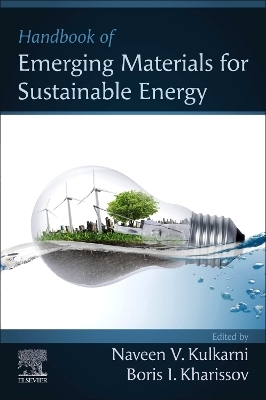
Handbook of Emerging Materials for Sustainable Energy
Elsevier - Health Sciences Division (Verlag)
978-0-323-96125-7 (ISBN)
The book concludes with three chapters related to advanced materials under development for energy conservation and environmental protection, including theories, methodologies and simulations established for advanced materials.
Naveen V. Kulkarni, PhD, is an Associate Professor in the Department of Chemistry, Amrita Vishwa Vidyapeetham, Amritapuri, Kerala, India. He obtained his PhD from Karnatak University Dharwad, India, and has worked at Technion (Israel), the University of Texas at Arlington (USA), the University of Rochester (USA), and the University of Cambridge (UK). Dr. Kulkarni has 18 years of experience in research relating to coordination chemistry, catalysis, energy materials, and environmental science. He has published over 50 research articles in reputed journals, authored book chapters, edited books and journal special issues, and conference proceedings. Boris I. Kharissov, PhD, is currently a Professor and Researcher at the Universidad Autónoma de Nuevo León (UANL), Mexico. He received his PhD in inorganic chemistry in 1993 from the Moscow State University, Russia and Dr. Hab. in physical chemistry in 2006 from Rostov State University, Russia. He also took part in the effort to deal with the consequences of the Chernobyl accident, working in the contaminated zone in 1987. His research specialisms include materials chemistry, coordination and inorganic chemistry, phthalocyanines, ultrasound, nanotechnology, chemical treatment of petroleum, and environmental remediation. Prof. Kharissov is the co-author of 16 books, 215 articles, 25 book chapters, and holds 8 patents. He has co-edited 3 invited special issues of international journals and is the member of the Editorial board of 6 journals. According to Elsevier’s data report (2023), he is within the top 2% of most cited scientists in the world.
Part 1: Advanced materials in battery technology
Recent advances of nanomaterials for rechargeable lithium-ion batteries: opportunities and challenges
Functional materials for solid-state battery applications
Part 2: Emerging materials in electrochemistry
Supercapacitors: basics and progress
Electrochemical capacitors: basic concepts and emerging nanomaterials for electrodes
Nanoporous silicon materials for solar energy by electrochemical approach
Mixed transition metal oxides for electrochemical energy storage
Bi- and trimetallic MOFs and their MOF-derived nanocarbons in electrocatalytic water splitting processes
Part 3: Novel materials for solar energy
Photovoltaic devices: dye sensitized and perovskite solar cells
Photovoltaics: background and novel carbon-based materials for third-generation solar cells
Photochromic molecules and materials: design and development
Designing heterostructures for production of solar fuels
Evacuated solar energy collector
Part 4: Emerging materials in photocatalysis
Nanostructured semiconductors for hydrogen production through photocatalyatic water splitting
Doped mixed phase transition metal oxides for photocatalysis
Graphitic carbon nitride as a metal free photocatalyst for solar water splitting
Lanthanide-based metal-organic frameworks as a promising visible light photocatalyst for hydrogen production
Part 5: Advanced materials for biofules and biohydrogen
Biofuels
Trends in valorization of biomass to biofuels: biobutanol
Bioethanol as an alternative energy resource for a sustainability: an approach
Biodiesel production from various nonedible plant seeds via transesterification process as an alternate feedstock
Microalgae as a source of sustainable energy resource for biofuels: a review
Mesoporous polymers for the catalytic conversion of biomass platform molecules to value-added chemicals
Sustainable biohydrogen production: technoeconomic analysis
Catalytic hydrogen generation from biomass and its derivatives
Part 6: Materials for carbon capture
Carbon dioxide sequestration, conversion and utilization
Carbon capture using NaCl (halite)
Carbon capture using halite, seawater, and saline water
Part 7: Modern materials for energy and environmental applications
Recent developments in techniques and technologies for analytical, spectroscopic, structural, and morphological characterization of modern materials of advanced applications
Recent trends and future potential of sustainable energy efficient materials for commercial buildings
Materials for energy-efficient systems and environmental remediation
Chalcogenide semiconductor nanocrystals—optoelectronic applications
Elemental semiconductor nanocrystals
Metal oxide nanocrystals— applications
Special modifying inorganic physical vapor deposition coatings and surface systems for sustainable energy products
Growth of 2D boron materials
Surface modification of metal-organic frameworks and their applications for the gas adsorption
| Erscheinungsdatum | 24.02.2024 |
|---|---|
| Verlagsort | Philadelphia |
| Sprache | englisch |
| Maße | 152 x 229 mm |
| Gewicht | 2100 g |
| Themenwelt | Technik ► Elektrotechnik / Energietechnik |
| Technik ► Maschinenbau | |
| ISBN-10 | 0-323-96125-8 / 0323961258 |
| ISBN-13 | 978-0-323-96125-7 / 9780323961257 |
| Zustand | Neuware |
| Haben Sie eine Frage zum Produkt? |
aus dem Bereich


